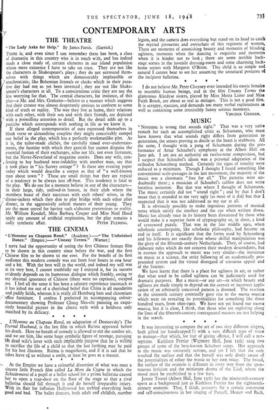MUSIC
" NOTHING is wrong that sounds right." That was a very naive remark for such an accomplished critic as Schumann, who must have known that what sounds right differs from generation to generation, the senses proving as docile as the heart is stubborn. All the same, I thought with a pang of Schumann during the per- formance of Artur Schnabel's symphony at the Albert Hall on June 9th. I am not an authority on twelve-tone composition, but I suspect that Schnabel's idiom was a personal adaptation of the orthodox Schoenberg method. Certainly the signs of tonality were reduced to a minimum. Though I thought I heard something like conventional scale-passages in the last movement, the majority of the music was a chromatic " free for all." The patterns were un- doubtedly there ; a musician of Schnabel's calibre does not write formless nonsense. But that was where I thought of Schumann. The music certainly did not " sound right " ; and by that I don't mean that it sounded to me very ugly (as most of it did) but that X suspected that it was not addressed to my ear at all.
It is obviously possible to make ingenious patterns of musical notes which satisfy the intellect and the eye when written down. Music has already once in its history been threatened by those who would make it a superior form of cryptography or, in short, a kind of crossword puzzle. That was in the late middle ages, when scholastic counterpoint, like scholastic philosophy, had become an end in itself. It is significant that the forms used by Schoenberg and his followers are exactly those whose .skilful manipulation was the glory of the fifteenth-century Netherlands. They, of course, had elaborate rules which do not concern their modern descendants, but in essence the approach to music was very similar—the insistence on music as a science, the strict following of an academically pro- pounded system and the virtual disregard of sensuous appeal and of the listener.
We have learnt that there is a place for ugliness in art, or rather that what used to be called ugliness can be judiciously used for dramatic purposes. But a music—or any art—in which beauty and ugliness are made simply to depend on the correct or incorrect appli- cation of an arbitrarily conceived pattern is doomed. The reaction in the sixteenth century eventually gave rise to the nuova musica which went on revealing its potentialities for something like three hundred years, from 1600-1900. We have not yet found our nuova, musica, but it is clear, I think, that those who are exploring along, the lines of the fifteenth-century contrapuntal masters are not helping
in the search. * * * *
It was interesting to compare the art of two very different singers, both gifted (or handicapped ?) with a very difficult type of voice to manage—that which, for fear of giving offence, I will call a not- soprano. Kathleen Ferrier (Wigmore Hall, June kith) sang two groups of some of the best-known Schubert songs. Her approach to the music was eminently serious, and yet I felt that she only touched the surface and that she herself was only dimly aware of the potentialities of either the music or her own voice. The broad, flat surface of the oratorio is different in every way from the spon- taneous lyricism and the miniature drama of the Lied, where the mood must be established in a few bars.
Jennie Tourel (Albert Hall, June 13th) has the nineteenth-century opera as a background just as Kathleen Ferrier has the eighteenth• century oratorio. That, I think, accounts for a certain constraint and self-consciousness in her singing of Purcell, Mozart and Bach. Her Debussy (three of the five early Baudelaire poems) and Spanish and Russian songs were far more spontaneous and showed her at her best—a very fine singer in whom art perhaps comes before nature, but whose art is worth a great deal more than the nature



































 Previous page
Previous page